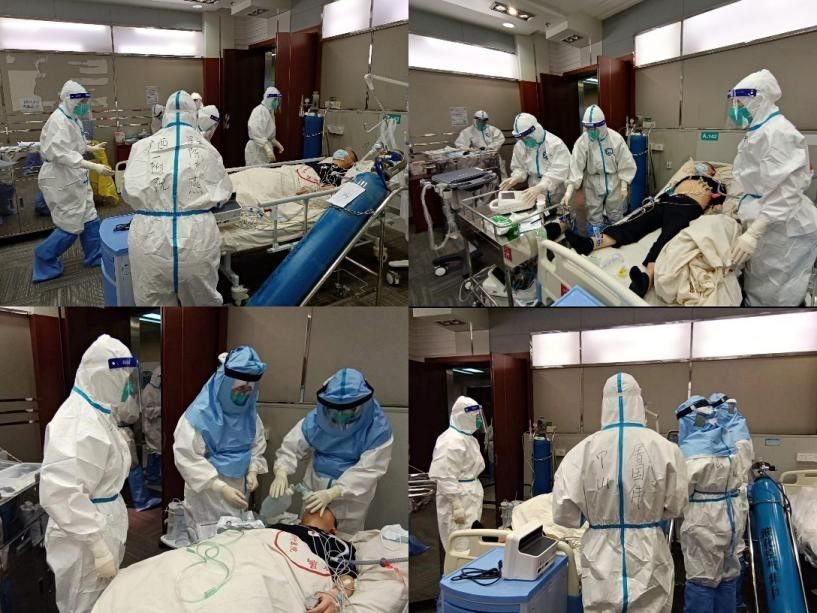“The patient has sudden chest pain, profuse sweating and respiratory distress, call the doctor!” “The patient loses consciousness, breathing and cardiac arrest!” Through the walkie-talkie, the nurse on duty sent an emergency message from the hospital’s red zone. If the condition of new crown infected patients suddenly changes in the designated hospital for treatment, how can medical staff take advantage of the existing conditions to respond quickly and treat these critically ill patients in a timely manner?
On May 13, the sub-designated hospital of Shanghai Minhang Gymnasium carried out an emergency treatment drill to further improve the emergency handling ability of clinical medical staff and strengthen the first aid skills of tracheal intubation and cardiopulmonary resuscitation for patients with new coronary pneumonia training. The drill was approved by the State Council Joint Prevention and Control Mechanism Expert Group.
The Minhang Gymnasium Fangcang shelter hospital started the construction of sub-designated hospitals on April 20, and has treated a large number of elderly patients with underlying diseases and potential high-risk new coronary pneumonia patients. In response to possible emergencies, the deputy head of the medical treatment team of the sub-designated hospital of Minhang Gymnasium, the chief physician Tu Guowei of the Department of Critical Care Medicine, Zhongshan Hospital Affiliated to Fudan University, and the head nurse Li Jingyi of the respiratory care unit jointly formulated a series of clinical plans and organized medical care for many times. Staff training. This drill is not only a training program for normalized emergency treatment, but also a staged assessment for accepting the learning outcomes of medical team members.
The first exercise was conducted by Chief Physician Tu Guowei of Zhongshan Hospital and Chief Physician Wei Yongxian of the Second Affiliated Hospital of Guangxi. A “patient” (patient volunteer) suddenly developed chest pain, profuse sweating, and respiratory distress. The nurse on duty performed ECG monitoring, inhaled oxygen, and called the doctor on duty. Physician Chen Bingyan combined the medical history and physical examination, perfected the electrocardiogram, blood gas analysis and bedside echocardiography, suspected pulmonary embolism, and successively performed high-flow oxygen inhalation and booster therapy, and called the intubation team doctor at the same time. After receiving the call, doctors Li Yuxin of Zhongshan Hospital and Li Zhenbin of Guangxi First Affiliated Hospital rushed into the red zone to quickly complete the endotracheal intubation.
 tracheal intubation drill site
tracheal intubation drill site
The second exercise was directed by head nurse Li Jingyi of Zhongshan Hospital and Qin Xiaohu, director of the Affiliated Hospital of Guilin Medical College. The simulated scenario is a patient who suddenly falls to the ground. After judging the patient’s loss of consciousness and respiratory and cardiac arrest, the nurse on duty immediately rescued the patient on the spot and started the emergency plan for cardiopulmonary resuscitation. The team transported the patient to the emergency room under continuous cardiopulmonary resuscitation. Rapid establishment of venous access, electric shock defibrillation, and tracheal intubation, the rescue work was carried out in an orderly manner. Laboratory tests and point-of-care ultrasound for rapid assessment of possible causes of cardiac arrest in patients. After active rescue, the patient’s vital signs stabilized and the resuscitation was successful. Then the medical staff began to rehearse transport with a ventilator and docked with “120”.
 CPR exercise scene
CPR exercise scene
The drill lasted nearly two hours. In addition to the personnel participating in the exercise, other medical staff watched and learned through video at the headquarters and the yellow zone. “The personnel participating in the drill are all on short notice and do not do ‘dress rehearsal’, because we are not a ‘performance’, but a ‘drill’. I hope that through such a drill, practical problems will be discovered and the success rate of treatment in emergencies will be improved. “Tu Guowei said. “This drill is organized to help medical staff truly experience rapid response thinking, on-site decision-making and team cooperation, and improve the clinical experience of treating critically ill patients with COVID-19.” Professor Sun Yihong, Vice President of Zhongshan Hospital and Commander of Minhang Gymnasium Sub-designated Hospital Say.
(Photo provided by Zhongshan Hospital)